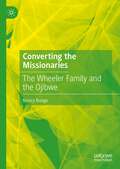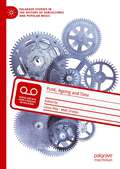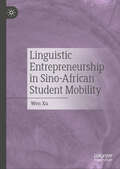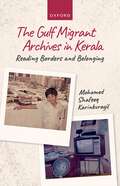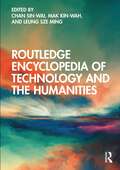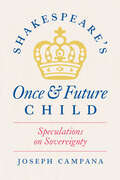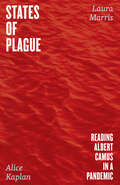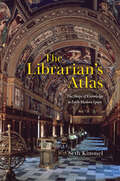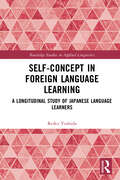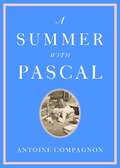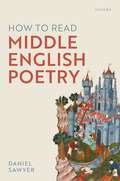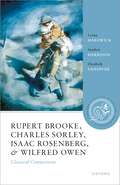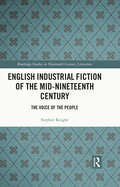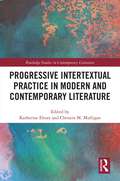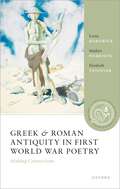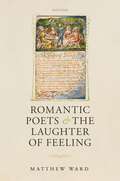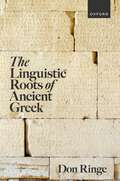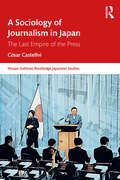- Table View
- List View
Converting the Missionaries: The Wheeler Family and the Ojibwe
by Nancy BungeThis book tells the uncommon story of a missionary family in the Midwestern United States, and their interactions with the indigenous Ojibwe. When Leonard and Harriet Wheeler arrived at La Pointe, Wisconsin in July of 1841, hoping to help the Ojibwe understand and accept the value of Christian civility, they did not expect such a profound transformation of their own lives. The Wheelers’ empathy for the Ojibwe not only grew during their twenty-five years of mission work in Northern Wisconsin, much of it spent trying to protect the Ojibwe from predatory whites, it also influenced the lives of their children.
Punk, Ageing and Time (Palgrave Studies in the History of Subcultures and Popular Music)
by Laura Way Matt GrimesTo date there has been no plotting of punk scholarship which speaks to ‘time’, yet there are some clear bodies of work pertaining to particular issues relevant to it, including ageing and/or the life course and punk, memory and/or nostalgia and punk, ‘punk history’, and archiving and punk. Punk, Ageing and Time is therefore a timely (pun intended) book. What this edited collection does for the first time is bring together contemporary investigations and discussions specifically around punk and ageing and/or time, covering areas such as: punk and ageing; the relationship between temporality and particular concepts relevant to punk (such as authenticity, DIY, identity, resistance, spatiality, style); and punk memory, remembering and/or forgetting. Multidisciplinary in nature, this book considers areas which have received very little to no academic attention previously.
Linguistic Entrepreneurship in Sino-African Student Mobility
by Wen XuThis book explores African international students’ lived experience within Chinese higher education, including their language ideologies, investment in Chinese language learning and the (re)shaping of identities and aspirations. Whilst high English proficiency has been sought by globally mobile students to play the ‘class game’ and gain entrée to the circle of elites, considerably less attention has been paid to how shifting global structures and China’s semi-peripheral position shape its language learners’ investment and identity construction. Drawing upon a series of interviews, the book deciphers African students’ logics of linguistic exchanges within the geopolitical and geo-economic context of China-African relations. The students invested heavily into Chinese language learning and use, while displaying perfectionism, linguistic entrepreneurship and linguistic insecurity. As the value of their Chinese linguistic capital increases, they reassessed their sense of themselves and produced different social identities, which includes the idea of ‘the world is my oyster’, contributing to Africa’s sustainable development and the disposition to ‘tell China’s story well’. This work transgresses monolingual dominance (i.e. English) in the existing body of international student mobility and second language acquisition (SLA) research, as great importance is assigned to Chinese as linguistic capital in South-South student migration. The book is of interest to researchers in international higher education, international student mobilities, sociolinguistics, applied linguistics, languages education, and Chinese language teaching and learning.
The Gulf Migrant Archives in Kerala: Reading Borders and Belonging
by Mohamed Shafeeq KarinkurayilThe Indian state of Kerala is one of the largest blocs of migrants in the oil economies of the Arab Gulf. Looking closely at the cultural archives produced by and on the Gulf migrants in Malayalam -- the predominant language of Kerala -- this book takes stock of circular migration beyond its economics. It combines formal and thematic analyses of photographs, films, and literature with anthropological and historical details to offer a nuanced understanding of the construction of the Gulf and its translation to the cultural imaginary of Kerala. It explores the dissonance between the private and public discourses on the Gulf among migrants and non-migrants, and demonstrates the role of this disjuncture in the continued fascination for Gulf migrant lives. An enquiry into the various dimensions of the Gulf in Kerala, as an acknowledged means of living, as a rumour, an object of gossip, a public secret, or even a private thrill, this book debunks the idea of language as a common entity and studies the tentative borders built within. Finally, it explores the resources, possibilities, and perils of affiliative communities constructed along and across those borders.
The Gulf Migrant Archives in Kerala: Reading Borders and Belonging
by Mohamed Shafeeq KarinkurayilThe Indian state of Kerala is one of the largest blocs of migrants in the oil economies of the Arab Gulf. Looking closely at the cultural archives produced by and on the Gulf migrants in Malayalam -- the predominant language of Kerala -- this book takes stock of circular migration beyond its economics. It combines formal and thematic analyses of photographs, films, and literature with anthropological and historical details to offer a nuanced understanding of the construction of the Gulf and its translation to the cultural imaginary of Kerala. It explores the dissonance between the private and public discourses on the Gulf among migrants and non-migrants, and demonstrates the role of this disjuncture in the continued fascination for Gulf migrant lives. An enquiry into the various dimensions of the Gulf in Kerala, as an acknowledged means of living, as a rumour, an object of gossip, a public secret, or even a private thrill, this book debunks the idea of language as a common entity and studies the tentative borders built within. Finally, it explores the resources, possibilities, and perils of affiliative communities constructed along and across those borders.
Routledge Encyclopedia of Technology and the Humanities
by Chan Sin-Wai Mak Kin-Wah Leung Sze MingRoutledge Encyclopedia of Technology and the Humanities is a pioneer attempt to introduce a wide range of disciplines in the emerging field of techno-humanities to the English-reading world.This book covers topics such as archaeology, cultural heritage, design, fashion, linguistics, music, philosophy, and translation. It has 20 chapters, contributed by 26 local and international scholars. Each chapter has its own theme and addresses issues of significant interest in the respective disciplines. References are provided at the end of each chapter for further exploration into the literature of the relevant areas. To facilitate an easy reading of the information presented in this volume, chapters have been arranged according to the alphabetical order of the topics covered.This Encyclopedia will appeal to researchers and professionals in the field of technology and the humanities, and can be used by undergraduate and graduate students studying the humanities.
Shakespeare's Once and Future Child: Speculations on Sovereignty
by Joseph CampanaA study of Shakespeare’s child figures in relation to their own political moment, as well as our own. Politicians are fond of saying that “children are the future.” How did the child become a figure for our political hopes? Joseph Campana’s book locates the source of this idea in transformations of childhood and political sovereignty during the age of Shakespeare, changes spectacularly dramatized by the playwright himself. Shakespeare’s works feature far more child figures—and more politically entangled children—than other literary or theatrical works of the era. Campana delves into this rich corpus to show how children and childhood expose assumptions about the shape of an ideal polity, the nature of citizenship, the growing importance of population and demographics, and the question of what is or is not human. As our ability to imagine viable futures on our planet feels ever more limited, and as children take up legal proceedings to sue on behalf of the future, it behooves us to understand the way past child figures haunt our conversations about intergenerational justice. Shakespeare offers critical precedents for questions we still struggle to answer.
States of Plague: Reading Albert Camus in a Pandemic
by Alice Kaplan Laura MarrisStates of Plague examines Albert Camus’s novel as a palimpsest of pandemic life, an uncannily relevant account of the psychology and politics of a public health crisis. As one of the most discussed books of the COVID-19 crisis, Albert Camus’s classic novel The Plague has become a new kind of literary touchstone. Surrounded by terror and uncertainty, often separated from loved ones or unable to travel, readers sought answers within the pages of Camus’s 1947 tale about an Algerian city gripped by an epidemic. Many found in it a story about their own lives—a book to shed light on a global health crisis. In thirteen linked chapters told in alternating voices, Alice Kaplan and Laura Marris hold the past and present of The Plague in conversation, discovering how the novel has reached people in their current moment. Kaplan’s chapters explore the book’s tangled and vivid history, while Marris’s are drawn to the ecology of landscape and language. Through these pages, they find that their sense of Camus evolves under the force of a new reality, alongside the pressures of illness, recovery, concern, and care in their own lives. Along the way, Kaplan and Marris examine how the novel’s original allegory might resonate with a new generation of readers who have experienced a global pandemic. They describe how they learned to contemplate the skies of a plague spring, to examine the body politic and the politics of immunity. Both personal and eloquently written, States of Plague uncovers for us the mysterious way a novel can imagine the world during a crisis and draw back the veil on other possible futures.
The Librarian's Atlas: The Shape of Knowledge in Early Modern Spain
by Seth KimmelA history of early modern libraries and the imperial desire for total knowledge. Medieval scholars imagined the library as a microcosm of the world, but as novel early modern ways of managing information facilitated empire in both the New and Old Worlds, the world became a projection of the library. In The Librarian’s Atlas, Seth Kimmel offers a sweeping material history of how the desire to catalog books coincided in the sixteenth and seventeenth centuries with the aspiration to control territory. Through a careful study of library culture in Spain and Morocco—close readings of catalogs, marginalia, indexes, commentaries, and maps—Kimmel reveals how the booklover’s dream of a comprehensive and well-organized library shaped an expanded sense of the world itself.
Shakespeare's Once and Future Child: Speculations on Sovereignty
by Joseph CampanaA study of Shakespeare’s child figures in relation to their own political moment, as well as our own. Politicians are fond of saying that “children are the future.” How did the child become a figure for our political hopes? Joseph Campana’s book locates the source of this idea in transformations of childhood and political sovereignty during the age of Shakespeare, changes spectacularly dramatized by the playwright himself. Shakespeare’s works feature far more child figures—and more politically entangled children—than other literary or theatrical works of the era. Campana delves into this rich corpus to show how children and childhood expose assumptions about the shape of an ideal polity, the nature of citizenship, the growing importance of population and demographics, and the question of what is or is not human. As our ability to imagine viable futures on our planet feels ever more limited, and as children take up legal proceedings to sue on behalf of the future, it behooves us to understand the way past child figures haunt our conversations about intergenerational justice. Shakespeare offers critical precedents for questions we still struggle to answer.
The Librarian's Atlas: The Shape of Knowledge in Early Modern Spain
by Seth KimmelA history of early modern libraries and the imperial desire for total knowledge. Medieval scholars imagined the library as a microcosm of the world, but as novel early modern ways of managing information facilitated empire in both the New and Old Worlds, the world became a projection of the library. In The Librarian’s Atlas, Seth Kimmel offers a sweeping material history of how the desire to catalog books coincided in the sixteenth and seventeenth centuries with the aspiration to control territory. Through a careful study of library culture in Spain and Morocco—close readings of catalogs, marginalia, indexes, commentaries, and maps—Kimmel reveals how the booklover’s dream of a comprehensive and well-organized library shaped an expanded sense of the world itself.
Self-Concept in Foreign Language Learning: A Longitudinal Study of Japanese Language Learners (Routledge Studies in Applied Linguistics)
by Reiko YoshidaThis book explores self-concept in foreign language (FL) learning, tracing the trajectories of a group of Japanese language learners at an Australian university to illuminate new insights about the factors impacting positive self-concept and implications for language learning more broadly.The volume calls attention to the ways in which learners’ perception of themselves as FL learners plays a fundamental role in FL learning. Drawing on data from a longitudinal study, including student diaries, interviews and classroom observations, Yoshida outlines shifts in self-concept as learners progress from secondary school to university courses to study abroad and beyond. The book demonstrates how the learner journey is marked by a growing recognition of the importance of practice for achievement but also a greater sense of self-consciousness, with learners’ agency in creating opportunities for themselves to practice their FL as a key factor in improving self-concept over time. This work offers unique observations about self-concept for learners who already ‘have’ global English as a first language, inspiring ways forward for future research and language teaching in other under-studied languages. The book will appeal to students and researchers in applied linguistics, SLA and foreign language learning, as well as stakeholders in Japanese language programs.
Self-Concept in Foreign Language Learning: A Longitudinal Study of Japanese Language Learners (Routledge Studies in Applied Linguistics)
by Reiko YoshidaThis book explores self-concept in foreign language (FL) learning, tracing the trajectories of a group of Japanese language learners at an Australian university to illuminate new insights about the factors impacting positive self-concept and implications for language learning more broadly.The volume calls attention to the ways in which learners’ perception of themselves as FL learners plays a fundamental role in FL learning. Drawing on data from a longitudinal study, including student diaries, interviews and classroom observations, Yoshida outlines shifts in self-concept as learners progress from secondary school to university courses to study abroad and beyond. The book demonstrates how the learner journey is marked by a growing recognition of the importance of practice for achievement but also a greater sense of self-consciousness, with learners’ agency in creating opportunities for themselves to practice their FL as a key factor in improving self-concept over time. This work offers unique observations about self-concept for learners who already ‘have’ global English as a first language, inspiring ways forward for future research and language teaching in other under-studied languages. The book will appeal to students and researchers in applied linguistics, SLA and foreign language learning, as well as stakeholders in Japanese language programs.
A Summer with Pascal
by Antoine CompagnonFrom an eminent scholar, a spirited introduction to one of the great polymaths in the history of Europe.Blaise Pascal (1623–1662) is best known in the English-speaking world for his contributions to mathematics and physics, with both a triangle and a law in fluid mechanics named after him. Meanwhile, the classic film My Night at Maud’s popularized Pascal’s wager, an invitation to faith that has inspired generations of theologians. Despite the immensity of his reputation, few read him outside French schools. In A Summer with Pascal, celebrated literary critic Antoine Compagnon opens our minds to a figure somehow both towering and ignored.Compagnon provides a bird’s-eye view of Pascal’s life and significance, making this volume an ideal introduction. Still, scholars and neophytes alike will profit greatly from his masterful readings of the Pensées—a cornerstone of Western philosophy—and the Provincial Letters, in which Pascal advanced wry theological critiques of his contemporaries. The concise, taut chapters build upon one another, easing into writings often thought to be forbidding and dour. With Compagnon as our guide, these works are not just accessible but enchanting.A Summer with Pascal brings the early modern thinker to life in the present. In an age of profound existential doubt and assaults on truth and reason, in which religion and science are so often crudely opposed, Pascal’s sophisticated commitment to both challenges us to meet the world with true intellectual vigor.
How to Read Middle English Poetry
by Daniel SawyerHow to Read Middle English Poetry guides readers through poetry between 1150 and 1500, for study and pleasure. Chapters give down-to-earth advice on enjoying and analyzing each aspect of verse, from the choice of single words, through syntax, metre, rhyme, and stanza-design, up to the play of larger forms across whole poems. How to Read Middle English Poetry covers major figures?such as Chaucer, Langland, the Pearl Poet, and Robert Henryson?but also delves into exciting anonymous lyrics, romances, and drama. It shows, too, how some modern poets have drawn on earlier poems, and how Middle English and early Scots provide crucial standpoints from which to think through present-day writing. Contextual sections discuss how poetry was heard aloud, introduce manuscripts and editing, and lay out Middle English poetry's ties to other tongues, including French, Welsh, and Latin. Critical terms are highlighted and explained both in the main text and in a full indexed glossary, while the uses of key tools such as the Middle English Dictionary are described and modeled. References to accessible editions and electronic resources mean that the book needs no accompanying anthology. At once thorough, wide-ranging, and practical, How to Read Middle English Poetry is indispensable for students exploring Middle English or early Scots, and for anyone curious about the heart of poetry's history.
Rupert Brooke, Charles Sorley, Isaac Rosenberg, and Wilfred Owen: Classical Connections (Oxford Classical Reception Commentaries)
by Lorna Hardwick Stephen Harrison Elizabeth VandiverRupert Brooke, Wilfred Owen, Isaac Rosenberg, and Charles Sorley all died in the First Word War. They came from diverse social, educational, and cultural backgrounds, but for all of the writers, engagement with Greek and Roman antiquity was decisive in shaping their war poetry. The world views and cultural hinterlands of Brooke and Sorley were framed by the Greek and Latin texts they had studied at school, whereas for Owen, who struggled with Latin, classical texts were a part of his aspirational literary imagination. Rosenberg's education was limited but he encountered some Greek and Roman literature through translations, and through mediations in English literature. The various ways in which the poets engaged with classical literature are analysed in the commentaries, which are designed to be accessible to classicists and to users from other subject areas. The extensive range of connections made by the poets and by subsequent readers is explained in the Introduction to the volume. The commentaries illuminate relationships between the poems and attitudes to the war at the time, in the immediate post-war years, and subsequently. They also probe how individual poems reveal various facets of the poetry of unease, the poetry of survival, and the poetics of war and ecology. References to the accompanying online Oxford Classical Receptions Commentaries will enable readers to follow up their special interests. This volume differs from the shorter volume Greek and Roman Antiquity in First World War Poetry: Making Connections in that it covers the whole output of the four poets, and not just their war poems.
English Industrial Fiction of the Mid-Nineteenth Century: The Voice of the People (Routledge Studies in Nineteenth Century Literature)
by Stephen KnightEnglish Industrial Fiction of the Mid-Nineteenth Century discusses the valuable fiction written in mid-nineteenth-century Britain which represents the situations of the new breed of industrial workers, both the mostly male factory workers who operated in the oppressive mills of the midlands and north and, in other stories, the oppressed seamstresses who worked mostly in London in very poor and low-paid conditions. Beginning with a general introduction to workers’ fiction at the start of the period, this volume charts the rise of an identifiable genre of industrial fiction and the development of a substantial mode of seamstress fiction through the 1840s, including an analysis of novels by Benjamin Disraeli, Charles Kingsley, Elizabeth Gaskell and Charles Dickens, and more briefly Charlotte Bronte, Geraldine Jewsbury and George Eliot. This volume is essential reading for students and scholars of industrial fiction and nineteenth-century Britain, or those with an interest in the relationship between literature, society and politics.
English Industrial Fiction of the Mid-Nineteenth Century: The Voice of the People (Routledge Studies in Nineteenth Century Literature)
by Stephen KnightEnglish Industrial Fiction of the Mid-Nineteenth Century discusses the valuable fiction written in mid-nineteenth-century Britain which represents the situations of the new breed of industrial workers, both the mostly male factory workers who operated in the oppressive mills of the midlands and north and, in other stories, the oppressed seamstresses who worked mostly in London in very poor and low-paid conditions. Beginning with a general introduction to workers’ fiction at the start of the period, this volume charts the rise of an identifiable genre of industrial fiction and the development of a substantial mode of seamstress fiction through the 1840s, including an analysis of novels by Benjamin Disraeli, Charles Kingsley, Elizabeth Gaskell and Charles Dickens, and more briefly Charlotte Bronte, Geraldine Jewsbury and George Eliot. This volume is essential reading for students and scholars of industrial fiction and nineteenth-century Britain, or those with an interest in the relationship between literature, society and politics.
Progressive Intertextual Practice In Modern And Contemporary Literature (Routledge Studies in Contemporary Literature)
This edited volume aims to reposition intertextuality in relation to recent trends in critical practice. Inspired by the work of Sara Ahmed in particular, our authors explore and reconfigure classic theories of authorship, influence and the text (including those by Roland Barthes, Michel Foucault and Harold Bloom), updating these conversations to include intersectionality specifically, broadly understood to include gendered, racial and other forms of social justice including disability, and the progressive impact of the transmission and transformation of texts. This diverse volume includes discussions of major canonical works such as James Joyce’s Ulysses alongside the recent contemporary literature by authors such as Siri Husvedt and Maggie O’Farrell, as well as theoretical interventions. This volume also engages with how intertextuality can facilitate interdisciplinary and ekphrastic thinking and representation, as the inspiration of music and the visual arts for texts and their transmission is addressed. The choice of intertexts become deliberately political, ethical and artistic signifiers for the authors discussed in this volume, and our contributors are thus enabled to address topics ranging from visual impairment to Shakespearean motherhood to the influence of Jazz culture on writing on the Northern Irish Troubles.
Greek and Roman Antiquity in First World War Poetry: Making Connections (Oxford Classical Reception Commentaries)
by Lorna Hardwick Stephen Harrison Elizabeth VandiverRupert Brooke, Wilfred Owen, Isaac Rosenberg, and Charles Sorley all died in the First Word War. They came from diverse social, educational, and cultural backgrounds, but for all of the writers, engagement with Greek and Roman antiquity was decisive in shaping their war poetry. The world views and cultural hinterlands of Brooke and Sorley were framed by the Greek and Latin texts they had studied at school, whereas for Owen, who struggled with Latin, classical texts were a part of his aspirational literary imagination. Rosenberg's education was limited but he encountered some Greek and Roman literature through translations, and through mediations in English literature. The various ways in which the poets engaged with classical literature are analysed in the commentaries, which are designed to be accessible to classicists and to users from other subject areas. The extensive range of connections made by the poets and by subsequent readers is explained in the Introduction to the volume. The commentaries illuminate relationships between the poems and attitudes to the war at the time, in the immediate post-war years, and subsequently. They also probe how individual poems reveal various facets of the poetry of unease, the poetry of survival, and the poetics of war and ecology.
How to Read Middle English Poetry
by Daniel SawyerHow to Read Middle English Poetry guides readers through poetry between 1150 and 1500, for study and pleasure. Chapters give down-to-earth advice on enjoying and analyzing each aspect of verse, from the choice of single words, through syntax, metre, rhyme, and stanza-design, up to the play of larger forms across whole poems. How to Read Middle English Poetry covers major figures?such as Chaucer, Langland, the Pearl Poet, and Robert Henryson?but also delves into exciting anonymous lyrics, romances, and drama. It shows, too, how some modern poets have drawn on earlier poems, and how Middle English and early Scots provide crucial standpoints from which to think through present-day writing. Contextual sections discuss how poetry was heard aloud, introduce manuscripts and editing, and lay out Middle English poetry's ties to other tongues, including French, Welsh, and Latin. Critical terms are highlighted and explained both in the main text and in a full indexed glossary, while the uses of key tools such as the Middle English Dictionary are described and modeled. References to accessible editions and electronic resources mean that the book needs no accompanying anthology. At once thorough, wide-ranging, and practical, How to Read Middle English Poetry is indispensable for students exploring Middle English or early Scots, and for anyone curious about the heart of poetry's history.
Progressive Intertextual Practice In Modern And Contemporary Literature (Routledge Studies in Contemporary Literature)
by Katherine Ebury Christin M. MulliganThis edited volume aims to reposition intertextuality in relation to recent trends in critical practice. Inspired by the work of Sara Ahmed in particular, our authors explore and reconfigure classic theories of authorship, influence and the text (including those by Roland Barthes, Michel Foucault and Harold Bloom), updating these conversations to include intersectionality specifically, broadly understood to include gendered, racial and other forms of social justice including disability, and the progressive impact of the transmission and transformation of texts. This diverse volume includes discussions of major canonical works such as James Joyce’s Ulysses alongside the recent contemporary literature by authors such as Siri Husvedt and Maggie O’Farrell, as well as theoretical interventions. This volume also engages with how intertextuality can facilitate interdisciplinary and ekphrastic thinking and representation, as the inspiration of music and the visual arts for texts and their transmission is addressed. The choice of intertexts become deliberately political, ethical and artistic signifiers for the authors discussed in this volume, and our contributors are thus enabled to address topics ranging from visual impairment to Shakespearean motherhood to the influence of Jazz culture on writing on the Northern Irish Troubles.
Romantic Poets and the Laughter of Feeling
by Matthew WardThe Romantic period witnessed decisive interest in how feeling might align with forms of artistic expression. Many critical studies have focused on the serious side and melancholic moods of Romantic poets. Romantic Poets and the Laughter of Feeling instead embraces the sublime and the ridiculous to offer an original and compelling new reading of British Romanticism. It reveals the decisive role laughter and the laughable play in Romantic aesthetics, emotions, and ethics. Matthew Ward shows that laughter was one of the primary means by which Romantics embraced and expanded upon, but also frequently aped and lampooned, sympathetic feeling. The laughter of feeling is both the expression of sympathy and an articulation of its implications, prejudices, and constraints. For Romantic poets like Wordsworth, Shelley, and Keats, the sound of laughter carries the hope that greater knowledge of others derives from feeling for and with them through poetry, and this might lead to a better understanding of oneself. Yet laughter also makes these poets acutely aware that our emotional lives are utterly unfamiliar and perhaps ultimately unknowable. Their prosody of laughter enlivens and exposes; it embodies their sense of?and ambitions for?poetry, and yet calls those matters into the most comical and gravest doubt. Laughter helps define what it is to be human. This book shows that it also defines what it is to be a 'Romantic' poet.
The Linguistic Roots of Ancient Greek
by Don RingeThis book traces the development of Greek from Proto-Indo-European to around the 5th century BC, drawing on all the tools of scientific historical and comparative linguistics. Don Ringe begins by outlining the grammar of Proto-Indo-European, focusing on its complex phonology, phonological rules, and inflectional morphology. He then discusses the changes in both phonology and inflectional morphology that took place in the development of Greek up to the point at which the dialects began to diverge, seeking to establish chronological relationships between those changes. The book places particular emphasis on the diversification of Greek into the attested groups of dialects, the relationship between those dialects, and the extent to which innovations spread across dialect boundaries. The final two chapters cover syntactic changes in the prehistory and history of Ancient Greek, and the sources of the Ancient Greek lexicon. The volume contributes to long-standing debates surrounding the classification of Ancient Greek dialects, and offers a discussion of the tension between cladistics and contact phenomena that is relevant to the study of the relationships within any language family.
A Sociology of Journalism in Japan: The Last Empire of the Press (ISSN)
by César CastellviThis book represents an in-depth analysis of journalism in Japan during the golden era of the daily press and the gradual introduction of digital technology starting from the mid-1980s to the late 2010s.By presenting firsthand testimony from journalists and field notes collected from fieldwork in the newsroom of one of the country's largest newspapers, this book provides a unique insight into Japan’s highly active yet relatively under-institutionalized journalistic profession. It also explores the changes experienced by the organizational development of Japanese journalism in response to broader changes in Japanese society, such as the emergence of social networks, the evolution of reading practices, the demographic situation, and the new aspirations of the Japanese youth.Based on an extensive ethnographic fieldwork carried out by the author over several years, this book will be of huge interest to students and scholars of Japanese society, journalism, and media studies.
